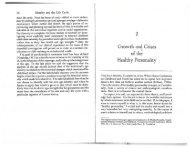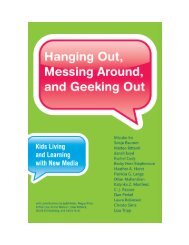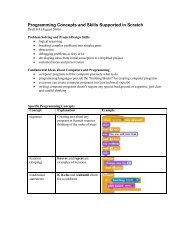Gaming Literacies: A Game Design Study in Action - MIT
Gaming Literacies: A Game Design Study in Action - MIT
Gaming Literacies: A Game Design Study in Action - MIT
Create successful ePaper yourself
Turn your PDF publications into a flip-book with our unique Google optimized e-Paper software.
<strong>Gam<strong>in</strong>g</strong> <strong>Literacies</strong>: A <strong>Game</strong> <strong>Design</strong> <strong>Study</strong> <strong>in</strong> <strong>Action</strong> 307<br />
to believe that literacy, language, and personal expression, will stem from<br />
<strong>in</strong>creas<strong>in</strong>g exposure to flexible rule sets and iterative systems for solv<strong>in</strong>g<br />
small problems.” Like Hall, the team beh<strong>in</strong>d <strong>Game</strong>star Mechanic shares <strong>in</strong><br />
the belief that exposure to the flexible rule sets and iterative play embodied<br />
<strong>in</strong> both design and gam<strong>in</strong>g practices are critical for th<strong>in</strong>k<strong>in</strong>g about literacy<br />
<strong>in</strong> the 21 st<br />
century. More specifically, we are explor<strong>in</strong>g the idea of literacies<br />
specific to gam<strong>in</strong>g and doma<strong>in</strong>s of media produced by games and supported<br />
through attitudes brought to bear on their play.<br />
<strong>Gam<strong>in</strong>g</strong> literacies emerge from what I call a gam<strong>in</strong>g attitude, which Jay<br />
Lemke (2006) refers to as a “stance of playfulness,” an attitude tied directly<br />
to the creative, improvisational, and subversive qualities of play. I <strong>in</strong>tentionally<br />
use the term gam<strong>in</strong>g literacies and not<br />
game literacies as my <strong>in</strong>terest is<br />
not simply <strong>in</strong> how digital games work (formally, socially, culturally, ideologically)<br />
but <strong>in</strong> how they support a performative and often transgressive learn<strong>in</strong>g<br />
stance based <strong>in</strong> play, which <strong>in</strong> turn, owes much of its specific character<br />
to the status of games as dynamic, rule-based systems. As designed systems,<br />
games offer certa<strong>in</strong> terms of engagement, rules of play that engender stylized<br />
forms of <strong>in</strong>teraction. <strong>Game</strong>rs not only follow rules, but push aga<strong>in</strong>st<br />
them, test<strong>in</strong>g the limits of the system <strong>in</strong> often unique and powerful ways.<br />
Learn<strong>in</strong>g to read a game system <strong>in</strong> order to play with it po<strong>in</strong>ts toward a<br />
specific k<strong>in</strong>d of literacy connected, <strong>in</strong> part, to the ability of a player to understand<br />
how systems operate, and how they can be transformed. Modd<strong>in</strong>g<br />
and world-build<strong>in</strong>g, which form the basis for much of the play of Massive<br />
Multiplayer Onl<strong>in</strong>e (MMO) games and virtual worlds, for example, might<br />
be one such literacy, while learn<strong>in</strong>g how to navigate a complex system of<br />
out-of-game resources, from game guides, FAQs, walkthroughs, and forums<br />
to peer-to-peer learn<strong>in</strong>g, might represent another. A third literacy might be<br />
seen <strong>in</strong> the learn<strong>in</strong>g that takes place <strong>in</strong> negotiat<strong>in</strong>g the variable demands<br />
of fair play: players must become literate <strong>in</strong> the social norms of a specific<br />
gam<strong>in</strong>g community learn<strong>in</strong>g what degree of transgression is acceptable and<br />
when a player has crossed the l<strong>in</strong>e. A fourth <strong>in</strong> learn<strong>in</strong>g how to collaborate<br />
with<strong>in</strong> a multiplayer space, where knowledge is distributed and action is<br />
most often collective.<br />
For those of us that design digital games, understand<strong>in</strong>g the ways <strong>in</strong><br />
which the structure of the medium itself elicits particular attitudes toward<br />
action and <strong>in</strong>teraction with the medium is endlessly beneficial. This <strong>in</strong>terest<br />
is heightened when the desire for understand<strong>in</strong>g is cast <strong>in</strong>to the context of<br />
learn<strong>in</strong>g and games. Because games are already robust learn<strong>in</strong>g systems, we<br />
must beg<strong>in</strong> to tease out the <strong>in</strong>tr<strong>in</strong>sic qualities and characteristics that guide<br />
the types of learn<strong>in</strong>g gam<strong>in</strong>g and games advance. Some of this work is be<strong>in</strong>g







